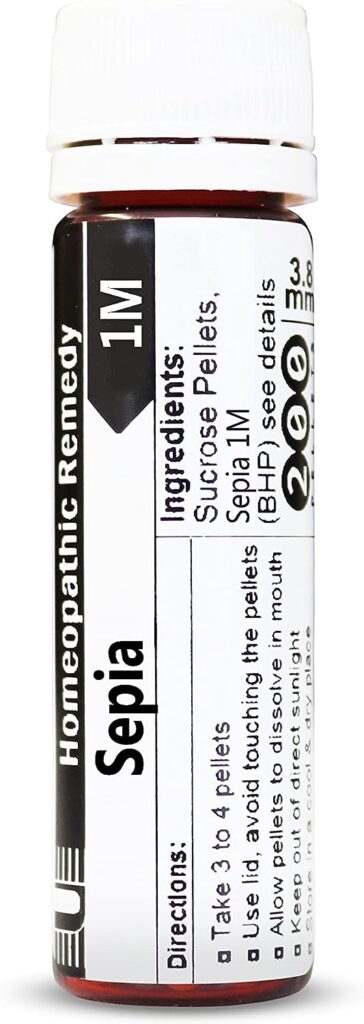Introduction
Sepia, a prominent homeopathic remedy derived from the ink sac of the cuttlefish, demonstrates remarkable influence over the nervous system, making it a quintessential choice for female-centric health concerns. This article unravels the diverse therapeutic spectrum of Sepia, shedding light on its profound impact on mental health, female disorders, skin ailments, and various bodily systems.

Origin and Preparation
The Sepia remedy is prepared from the dried liquid found in the ink sac of the cuttlefish, an organism native to the Mediterranean Sea. The process of trituration transforms this ink into a potent homeopathic remedy, ready to address a multitude of ailments, with a special emphasis on those affecting women.
The ‘Sepia’ Constitution
Individuals who benefit most from Sepia often exhibit specific physical features, including dark hair, sallow complexion, and a slender build. These individuals typically possess mild and amiable dispositions but can be highly excitable, anxious, and sensitive. Sepia primarily serves as a remedy for women, with two distinct personality types:
1. Tall, Slim, and Slender Constitution:
- Well-suited for tall, slim women with a narrow pelvis and relaxed pelvic organs.
- Particularly beneficial during pregnancy, childbirth, lactation, and menopause.
- May be associated with irritable tendencies and a disposition akin to washerwomen.
- Sensitivity to cold air and susceptibility to fainting upon exposure to extreme temperatures.
2. Pot-Bellied Constitution with Irritability:
- Characterized by a pot-bellied physique, yellow saddle-like discoloration across the nose, and irritable nature.
- Referred to as the ‘washer woman’s remedy’ due to its effectiveness in addressing complaints aggravated by or associated with laundry work.
- Pronounced sensitivity to temperature variations.

Clinical Indications
Sepia has garnered extensive use in the homeopathic tradition for a wide array of medical conditions, including but not limited to:
- Depression
- Menstrual irregularities and hormonal imbalances
- Menopausal symptoms, including hot flashes and mood swings
- Uterine prolapse
- Polycystic ovarian syndrome (PCOS)
- Leucorrhoea and vaginitis
- Premenstrual syndrome (PMS)
- Dysmenorrhoea and postpartum depression
- Genital herpes
- Hair loss during menopause
- Ovarian cysts
- Urinary issues like bedwetting, urinary incontinence, and kidney stones
- Skin conditions such as chloasma, psoriasis, and urticaria
- Gastrointestinal and hepatic problems
- Rectal complaints, including constipation and piles
Mental Health and Female Disorders
Sepia’s impact on mental health is profound, particularly in cases of depression characterized by excessive sadness, indifference, and aversion to work. It is often prescribed for women experiencing postpartum depression and menopausal mood disturbances, leading to melancholic moods, weeping spells, and a general loss of interest in life. The Sepia individual tends to be highly irritable, sensitive, and anxious, with marked aversion to company. Additionally, Sepia can address memory issues and fatigue accompanying mental distress.
In the realm of female disorders, Sepia shines as a solution for menstrual irregularities, hormonal imbalances, and uterine prolapse. It effectively manages conditions like dyspareunia, low libido, and aversion to sex, especially when associated with dryness and bleeding. Furthermore, Sepia offers respite from ovarian cysts and plays a significant role in the management of PCOS, helping to regulate menstrual cycles and alleviate symptoms like hair fall and acne.
Urological and Skin Ailments
Sepia’s therapeutic reach extends to urinary problems, effectively addressing bedwetting, urinary incontinence, kidney stones, and urinary tract infections (UTIs). It excels in managing the discomfort of cystitis, characterized by pain, pressure, and an urgent need to urinate, with foul-smelling, blood-stained urine.
In dermatology, Sepia’s applications span a multitude of conditions, including chloasma, ringworm infections, psoriasis, icthyosis, and urticaria. It addresses excessive perspiration, offensive body odor, warts, freckles, and even hair loss, especially during menopause.

Gastric, Hepatic, and Rectal Disturbances
Individuals experiencing sinking sensations, fullness, and abdominal pain after meals, as well as gastric cramping and burning, can find relief with Sepia. It also proves beneficial for managing hepatic discomfort marked by pressure, soreness, and dull stitches in the liver region.
Sepia’s efficacy extends to rectal complaints, particularly constipation characterized by hard, knotty stool, tenesmus, and pain during and after bowel movements. It also offers solace to those grappling with piles that protrude during defecation.
Dosage and Complementary Remedies
Sepia is available in various potencies ranging from 30C to 1M, with dosage tailored to individual cases. Complementary remedies include Nux Vomica and Natrum Mur, while subsequent remedies may include Belladonna, Calc Carb, Graphites, Lycopodium, Pulsatilla, Silicea, and Sulphur.
If considering Sepia or any other homeopathic remedy, it’s advisable to seek consultation with a qualified homeopath. Homeopathic treatments are individualized, and the appropriate dosage varies based on each person’s unique constitution, symptoms, and needs. A skilled homeopath will take into account your specific health profile to determine the optimal potency and frequency of dosing, ensuring safe and effective treatment tailored to your condition.
